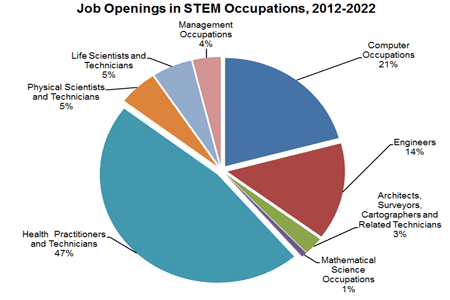A conversation about occupations considered recession resistant would need to include electrical engineers, software engineers, software developers, web developers, UI/UX designers. You’d also have to add all the related positions such as business analysts, project managers, database professionals, information security professionals, and IT infrastructure engineers.
The state of Oregon Economic Development Department refers to these categories of jobs as part of “computer systems design services, consultants, and specialized design services.” This segment includes the work done by engineering companies and R&D.
This group of businesses withstood the recession relatively well and also propelled job growth during the recovery. These industries have helped power economic growth following the recession as well.
The state of Oregon Economic Development Department refers to the jobs created in such industries as STEM (Science, Technology, Engineering and Math) oriented professions.
These, professional, scientific, and technical jobs employ over 80,000 people in Oregon. Although it makes up just 4.8 percent of employment, it accounts for 12.8 percent of the state’s net job gains since 2010.
With a shift to a more technical and STEM-oriented economy, professional, scientific, and technical service occupations’ share of total employment has increased steadily over the last 10 years. In 2003, it accounted for 3.9 percent of Oregon employment – with that figure increasing to nearly 5 percent in 2013. That change has been equally impactful across the nation.
In Oregon one out of every nine jobs is in a STEM occupation, and from 2012 to 2022, one out of every eight new jobs is expected to be a STEM job.
A list of popular STEM-oriented occupations would include:
- Software Development and Engineering
- Infrastructure and IT Support
- Database and Information Security
- Project Management & Business Analytics
- Mobile Technologies
- ERP Software Customization and Support
- Hardware, Device, and Embedded Systems
- Quality Assurance and Software Testing
- Healthcare IT and Technology
- Cloud and Big Data Technologies
- Help Desk and Technical Support
- Technology Communications
How to Prepare for a STEM Job
Landing a STEM job typically requires education beyond a high school diploma. Most of these jobs are technical and require specific education and training to learn the skills and knowledge for them. Only a small fraction of STEM jobs have less than postsecondary education as the typical entry level education (see graph below). The typical entry for two-thirds of the job openings is two to four years of college education.

Will there be Enough Qualified STEM Job Candidates?
There has been concern expressed whether there will be enough graduates with STEM skills to meet demands. The good news is that education planners and policy makers working to assure an adequate supply to meet the needs.
Oregon has a STEM Investment Council in place to help develop and oversee efforts to meet these STEM-related educational goals by 2025:
- Double the percentage of students in 4th and 8th grades who are proficient or advanced in mathematics and science.
- Double the number of students who earn a post-secondary degree requiring proficiency in science, technology, engineering, or mathematics.
With an increase in the concentration of STEM jobs, and strong job growth record, the future is bright for those with the right skill-set. STEM jobs pay well too, with $66,364 wage average in 2013, nearly 50 percent higher than the average pay across all industries ($45,009).
From 2012 to 2022, the growth rate for STEM jobs is expected to be 17.7 percent, higher than the 15.4 per rate for all occupations – as more than 71,000 job openings are predicted.

The STEM Job Future is Bright
Strong STEM job growth is projected over the coming years – with Oregon’s professional, scientific, and technical services occupations predicted to grow 27 percent by 2022, delivering an additional 20,800 jobs (when employment across all industries is expected to increase at the rate of just 15.3 percent). With the computer systems design sector of STEM at a projected growth rate of 42 percent, it’s expected to be one the state’s fastest-growing industries – and will be a leader within the segment of STEM occupations… and economy-wide.
Thank you to the Oregon Employment Department (OED) for the research, data, and graphs in this article. http://www.qualityinfo.org/olmisj/OlmisZine



